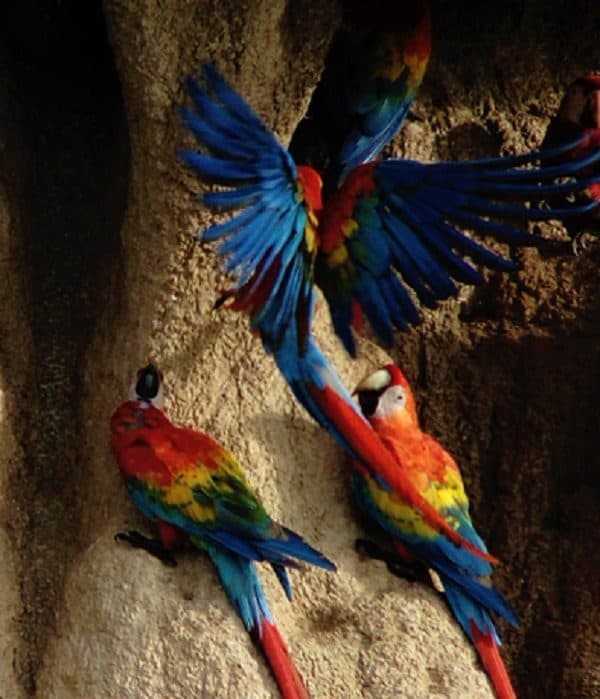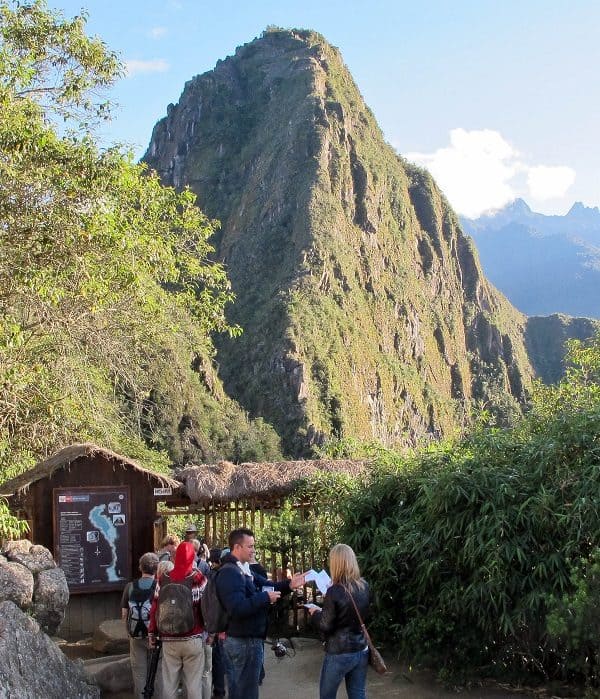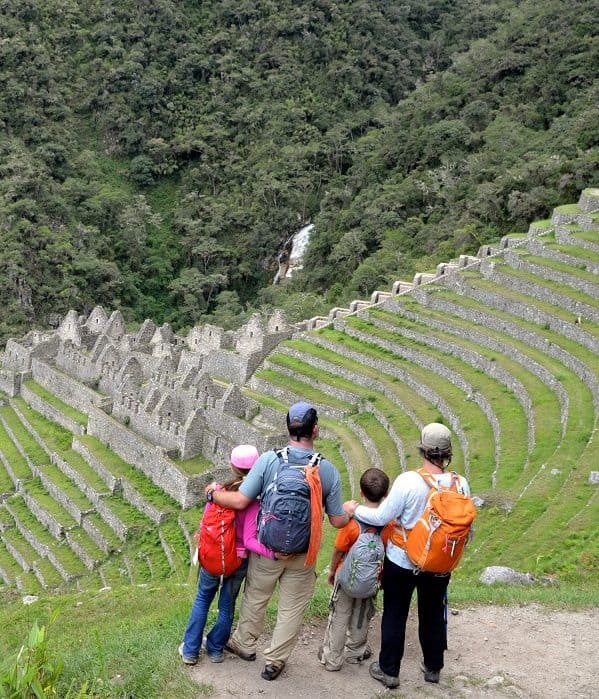ABOUT PERU
The magical country that has it all
Peru


Tambopata National Park (on the left) is one of the most beautiful places to watch wildlife. Machu Pichu (center) is one of the 7 new world wonders. And, the Inca trail (on the right) is one of the most beautiful treks on the planet.

Peru International Records
Here are some international records and recognitions that Peru has achieved in biodiversity and tourist destinations:
Biodiversity:
- Largest variety of orchids: Peru is home to over 4,000 species of orchids, which is the largest variety in the world.
- Highest biodiversity in the Amazon: The Peruvian Amazon is considered one of the most biodiverse regions in the world, with over 10% of all known plant and animal species found there.
- Most endemic species: Peru has the highest number of endemic species in the world, with over 1,500 species found nowhere else on Earth.
- UNESCO Biosphere Reserve: The Manu National Park in Peru is a UNESCO Biosphere Reserve, recognized for its exceptional biodiversity and conservation efforts.
- IUCN Red List: Peru has the highest number of species listed on the IUCN Red List, with over 1,000 species considered endangered or critically endangered.
Tourist Destinations:
- One of the 7 Wonders of the World: Machu Picchu, an Inca citadel in Peru, is one of the 7 Wonders of the World, as designated by the New7Wonders Foundation.
- Top 10 tourist destinations: Peru is ranked among the top 10 tourist destinations in South America, according to the World Tourism Organization (UNWTO).
- Lonely Planet’s Top 10: Peru is listed as one of the top 10 countries to visit in 2020 by Lonely Planet, a leading travel guidebook publisher.
- Travel + Leisure’s Top 10: Peru is ranked among the top 10 countries in the world for travel in 2020 by Travel + Leisure, a leading travel magazine.
- Guinness World Record: Peru holds the Guinness World Record for the most UNESCO World Heritage Sites in a single country, with 12 sites recognized for their cultural and natural significance.
These records and recognitions demonstrate Peru’s rich biodiversity and its importance as a tourist destination, attracting visitors from around the world to experience its unique cultural and natural heritage.
About Machu Picchu
What is Machu Picchu to the world?
Machu Picchu is an Inca citadel located in the Cusco Region of Peru, and it is considered one of the most famous and mysterious sites in South America. It is a UNESCO World Heritage Site and one of the Seven Wonders of the World. Machu Picchu is a symbol of Peruvian culture and identity, and it is a major tourist destination, attracting millions of visitors each year.
What was Machu Picchu in Inca times?
Machu Picchu was built in the 15th century by the Inca Empire, which was a powerful and advanced civilization that flourished in the Andean region of South America. The Inca Empire was known for its impressive architecture, engineering, and agricultural achievements, and Machu Picchu is one of its most impressive and enduring legacies.
In Inca times, Machu Picchu was a sacred city, a place of worship, and a royal estate. It was built as a retreat for the Inca emperor Pachacuti, who was the founder of the Inca Empire. The city was designed to be a self-sufficient community, with its own agricultural system, water supply, and infrastructure.
Machu Picchu was also a strategic military outpost, as it was located on a mountain ridge that controlled access to the Sacred Valley of the Incas. The city was built to be a place of refuge and protection, and it was designed to be difficult to access, with steep cliffs and narrow paths that made it hard for enemies to reach.
What was the purpose of Machu Picchu?
The purpose of Machu Picchu is still debated among historians and archaeologists, but it is believed to have served several purposes:
- Royal estate: Machu Picchu was a retreat for the Inca emperor and his family, where they could escape the heat and humidity of the lowlands.
- Sacred city: Machu Picchu was a place of worship, where the Incas would perform rituals and ceremonies to honor their gods and goddesses.
- Military outpost: Machu Picchu was a strategic military outpost, designed to protect the Inca Empire from external threats.
- Agricultural center: Machu Picchu was a center for agriculture, with terraces and irrigation systems that allowed the Incas to grow crops in the highlands.
- Symbol of power: Machu Picchu was a symbol of the power and wealth of the Inca Empire, and it was a testament to the engineering and architectural skills of the Incas.
Overall, Machu Picchu was a complex and multifaceted site that served as a royal estate, a sacred city, a military outpost, an agricultural center, and a symbol of power for the Inca Empire.
Peruvian cuisine
Peruvian Cuisine: A Fusion of Flavors and Cultures
Peruvian cuisine is a unique blend of indigenous, Spanish, African, and Asian influences, shaped by the country’s rich cultural heritage and geographical diversity. Peruvian dishes are known for their bold flavors, vibrant colors, and varied textures, making them a delight for the senses. Here are some of the most popular and iconic Peruvian meals that have gained international recognition:
- Ceviche: A refreshing and flavorful dish made with raw fish marinated in citrus juices, onions, and spices. Ceviche is a staple in Peruvian cuisine and is often served as an appetizer or main course.
- Lomo Saltado: A popular stir-fry dish made with beef strips, onions, tomatoes, and French fries, served with rice and a fried egg. Lomo Saltado is a fusion of Peruvian and Chinese cuisine.
- Aji de Gallina: A creamy and spicy chicken dish made with shredded chicken cooked in aji amarillo pepper sauce, served with rice and boiled potatoes.
- Anticuchos: Grilled beef heart skewers, typically served as a street food or appetizer. Anticuchos are a popular snack in Peru and are often seasoned with garlic, salt, and chili peppers.
- Papa a la Huancaina: A hearty and flavorful dish made with boiled potatoes topped with a spicy cheese sauce, lettuce, and olives.
- Cuy: A traditional Andean dish made with roasted guinea pig, often served with potatoes, corn, and vegetables. Cuy is a symbol of Peruvian cuisine and is often served on special occasions.
- Tiradito: A Peruvian-style sashimi made with raw fish marinated in citrus juices, onions, and spices, similar to ceviche but with a more delicate flavor.
- Picarones: Sweet potato donuts, typically served with chancaca, a type of raw sugar cane syrup. Picarones are a popular street food in Peru and are often enjoyed during festivals and celebrations.
- Chupe de Camarones: A hearty and flavorful shrimp soup made with shrimp, onions, garlic, and potatoes, served with crusty bread.
Peruvian cuisine has gained international recognition, with many restaurants and chefs around the world incorporating Peruvian flavors and ingredients into their menus. The country’s unique culinary heritage has also inspired a new generation of Peruvian chefs, who are pushing the boundaries of traditional cuisine and creating innovative and delicious dishes.
Peru top destinations
Discover Peru: An Adventure Awaits!
Hey there, fellow travelers! If you’re dreaming about your next epic adventure, let me tell you why Peru should be at the top of your list. This incredible country has it all: ancient ruins, vibrant cities, mouth-watering food, and landscapes that look like they’ve been plucked straight out of a postcard. So, pack your bags and let’s dive into the wonders of Peru!
Lima: The Culinary Capital
First stop: Lima! This bustling metropolis is the perfect mix of old and new, with colonial architecture standing shoulder to shoulder with sleek modern buildings. But let’s be real – the real star here is the food. Lima’s culinary scene is off the charts. From ceviche to lomo saltado, the flavors will blow your mind. Be sure to hit up a few local markets for the freshest ingredients and try out some cooking classes with top chefs. Oh, and don’t miss out on trying pisco sours – it’s practically a rite of passage!
Cusco: Gateway to History
Next, we’re heading to Cusco, the historic heart of the Inca Empire. Wandering through the cobblestone streets feels like stepping back in time. The blend of Incan and Spanish colonial architecture is mesmerizing. Make sure to visit the impressive Qorikancha temple and the sprawling Sacsayhuaman fortress. Cusco is also the launching pad for the journey to Machu Picchu, so get ready for some serious adventure!
Machu Picchu: The Crown Jewel
Speaking of Machu Picchu, no trip to Peru is complete without visiting this iconic site. Whether you hike the classic Inca Trail or take the scenic train ride, arriving at Machu Picchu is nothing short of magical. The misty mountain backdrop and the ancient ruins are simply breathtaking. Pro tip: try to catch the sunrise – it’s an unforgettable experience.
The Sacred Valley: Nature and Culture
Just outside Cusco lies the Sacred Valley, a lush region filled with charming villages, terraced fields, and towering Andean peaks. This area is perfect for adventure enthusiasts. Think mountain biking, river rafting, and horseback riding. Plus, the local markets in towns like Pisac and Ollantaytambo are perfect for picking up unique souvenirs and getting a taste of local life.
Lake Titicaca: Floating Islands and Rich Traditions
Next up, we have Lake Titicaca, the highest navigable lake in the world. It’s a serene spot with stunning blue waters and fascinating floating islands made entirely of reeds. The Uros people who live here have maintained their traditional way of life for centuries. Spending a night on one of these islands is a unique way to immerse yourself in their culture.
The Amazon Rainforest: Wildlife Wonders
For a totally different experience, head to the Peruvian Amazon. Base yourself in Iquitos or Puerto Maldonado and embark on a jungle adventure. Whether you’re canoeing down the river, hiking through dense forests, or spotting exotic wildlife like pink dolphins and colorful macaws, the Amazon offers an unforgettable connection with nature.
Arequipa: The White City
Last but not least, don’t miss Arequipa, known as the White City due to its stunning white volcanic stone buildings. The city is surrounded by three majestic volcanoes, and its historic center is a UNESCO World Heritage Site. Visit the Santa Catalina Monastery, a vibrant and colorful convent that feels like a city within a city. And make sure to try the local cuisine – Arequipa has its own unique flavors that are absolutely delicious.
Tips to travel to Peru
Here are some of the best advices for traveling to Peru:
- Plan ahead: Peru is a popular destination, and popular attractions can get crowded. Plan your itinerary in advance to ensure that you have enough time to visit the places you want to see.
Learn some Spanish: While many Peruvians speak some English, it’s still a good idea to learn some basic Spanish phrases to help you navigate the country. - Pack accordingly: Peru’s climate varies greatly depending on the region, so be sure to pack accordingly. Bring layers for cooler mornings and evenings, and comfortable shoes for hiking and exploring.
- Respect local customs: Peru is a conservative country, and it’s important to respect local customs and traditions. For example, dress modestly when visiting churches or other religious sites.
- Try the local food: Peruvian cuisine is delicious and varied, and you should definitely try some of the local specialties like ceviche, lomo saltado, and aji de gallina.
- Be prepared for altitude: Cusco and other high-altitude cities can be challenging for visitors who are not used to the thin air. Be sure to drink plenty of water and take it easy for the first few days.
- Use reputable tour operators: When booking tours or activities, make sure to use reputable operators to ensure your safety and well-being.
- Be mindful of your belongings: Peru is generally a safe country, but it’s still important to be mindful of your belongings and keep an eye on your valuables.
- Learn about the history and culture: Peru has a rich history and culture, and learning about it will help you appreciate your trip even more. Take the time to visit museums, historical sites, and cultural events.
- Be prepared for crowds: Peru is a popular destination, and popular attractions can get crowded. Be prepared for crowds and long lines, especially during peak travel season.
- Use cash: While many places in Peru accept credit cards, it’s still a good idea to have some cash on hand, especially for smaller shops and markets.
- Respect the environment: Peru is a beautiful country with a rich natural environment. Be sure to respect the environment and follow any rules or regulations that are in place to protect it.
- Learn about the different regions: Peru is a large country with many different regions, each with its own unique culture and attractions. Learn about the different regions and plan your trip accordingly.
